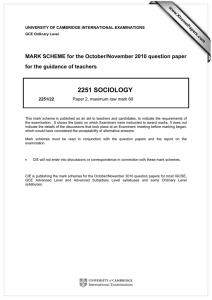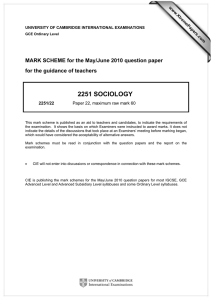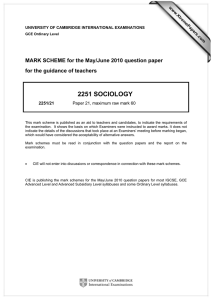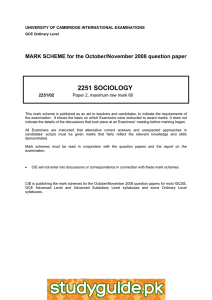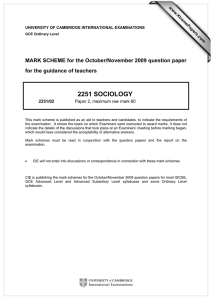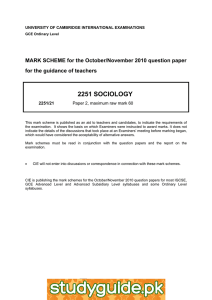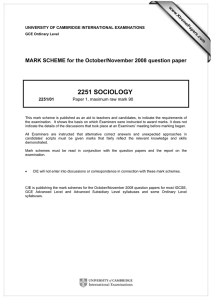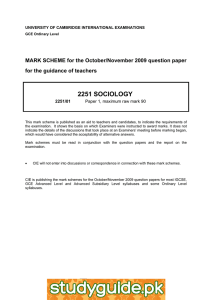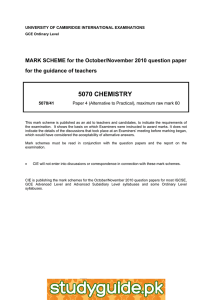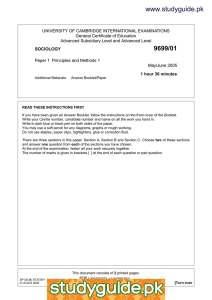2251 SOCIOLOGY MARK SCHEME for the October/November 2010 question paper
advertisement
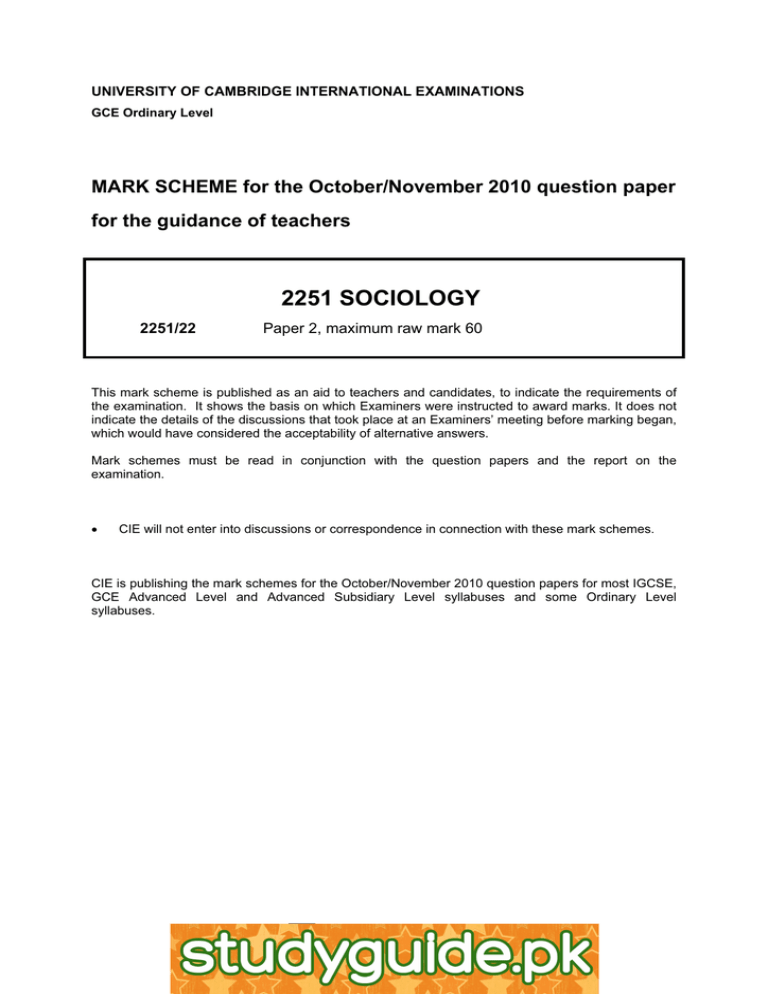
UNIVERSITY OF CAMBRIDGE INTERNATIONAL EXAMINATIONS GCE Ordinary Level MARK SCHEME for the October/November 2010 question paper for the guidance of teachers 2251 SOCIOLOGY 2251/22 Paper 2, maximum raw mark 60 This mark scheme is published as an aid to teachers and candidates, to indicate the requirements of the examination. It shows the basis on which Examiners were instructed to award marks. It does not indicate the details of the discussions that took place at an Examiners’ meeting before marking began, which would have considered the acceptability of alternative answers. Mark schemes must be read in conjunction with the question papers and the report on the examination. • CIE will not enter into discussions or correspondence in connection with these mark schemes. CIE is publishing the mark schemes for the October/November 2010 question papers for most IGCSE, GCE Advanced Level and Advanced Subsidiary Level syllabuses and some Ordinary Level syllabuses. www.XtremePapers.net Page 2 Mark Scheme: Teachers’ version GCE O LEVEL – October/November 2010 Syllabus 2251 Paper 22 Section A: The Family 1 In traditional societies the functions of the family are different, to some extent, from those performed by the family in modern industrial societies. (a) What is meant by the term traditional society? [2] A society where religion and custom play a key part in organising and regulating people’s lives. Two marks for a clear definition along these lines and one mark for a partial definition showing some understanding. (b) Describe two functions that are carried out by the family in all societies. [4] Universal functions of the family include: regulation of sexual behaviour, reproduction, socialisation of young children, and some form of economic support. (2 × 2) (c) Explain how the functions performed by the family have changed as societies have modernised. [6] 0–3 A simple notion of a loss of functions, or a narrowing of functions, with no further development would justify a mark in this band. 4–6 Answers at this level will show clearly in what ways the functions of the family have changed with the move to modern industrial societies. At the top of the band, candidates may include references to the sharing or transfer of functions to the state and other institutions. (d) How far, and in what ways, are families in modern industrial societies still as important as they were in the past? [8] 0–3 A few basic points, probably relying on assertion rather than sociological reasoning. 4–6 Two or three basic points about, for example, the rising divorce rate, loss of functions, decline in first marriages and/or increase in remarriages. 7–8 Several relevant points will be discussed and, at the top of the band, the answer will be an explicit assessment of whether families are still as important as in the past. © UCLES 2010 www.XtremePapers.net Page 3 2 Mark Scheme: Teachers’ version GCE O LEVEL – October/November 2010 Syllabus 2251 Paper 22 It is argued that in modern industrial societies there has been a move from segregated conjugal roles to more integrated conjugal roles, giving rise to the symmetrical family. (a) What is meant by the term symmetrical family? [2] One in which the roles of partners have become more alike and equal. A clear definition along these lines = 2 marks. An incomplete definition showing some understanding = 1 mark. (b) Describe the difference between segregated and integrated conjugal roles. [4] Segregated conjugal roles: where there is a clear division and separation of the male and female role within a partnership. Integrated conjugal roles: also known as joint conjugal roles, where the divisions between male and female roles are less distinct. (c) Explain the reasons why the symmetrical family has become more common in modern industrial societies. [6] Reasons include: increasing employment opportunities for women; less dependence on male partner; improved standards of living leading to shared home-centred leisure; the decline in the close-knit extended family/isolation of the nuclear family and changing social attitudes. 0–3 Answers at this level are likely to be confined to a few isolated points of general relevance to the question. There may be little sociological depth or the range of points will be narrow. 4–6 Several well-developed factors will appear, showing good sociological understanding. (d) To what extent is the nuclear family still the dominant type of family unit in modern industrial societies? [8] 0–3 Answers at this level may be confined to generalisation and common sense, with little linkage to the question. 4–6 A few relevant sociological points will appear, arguing for and/or against the idea that the nuclear family is in decline in modern industrial societies. Reference to the diversity of family types may be discussed. 7–8 The answer should consider arguments both for and against the claim that the nuclear family is declining in modern industrial societies. At this level, there will be some attempt at assessment. © UCLES 2010 www.XtremePapers.net Page 4 Mark Scheme: Teachers’ version GCE O LEVEL – October/November 2010 Syllabus 2251 Paper 22 Section B: Education 3 The formal and informal curriculum can both be an influence on pupils’ opportunities for upward social mobility. (a) What is meant by the term informal curriculum? [2] Everything that pupils learn which is not part of the formal curriculum, e.g. norms, values and rules. Two marks for a clear definition along these lines and one mark for a partial definition showing some understanding. (b) Describe two ways in which the formal curriculum can help children from poor families achieve upward social mobility. [4] Examples include: the teaching of skills for employment/training, qualifications, free education and school equipment, compensatory education, socialisation and social control. 1 mark for each example and 1 mark for development. (2 × 2) (c) Explain why children from poor families often underachieve at school. [6] 0–3 A few basic points with little sociological backing. 4–6 A range of factors covering relevant points will be offered, e.g. low expectations; needing to leave school to get a job; having to pay for education; few role models; middle class nature of schooling; teachers and parental attitudes. (d) How far, and in what ways, can schooling have a negative influence on the educational performance of children from poor families? [8] 0–3 A few commonsensical points, lacking development, can be expected at this level. 4–6 A range of appropriate suggestions will appear at this level, including: compensatory education programmes; strategies to promote equal opportunities, e.g. mixed ability teaching; recruitment of teachers from working class backgrounds; home/school initiatives; encouraging role models of deprived children being successful at school. 7–8 To reach the top of the band, the second part of the question (how likely are they to succeed?) must be answered. © UCLES 2010 www.XtremePapers.net Page 5 4 Mark Scheme: Teachers’ version GCE O LEVEL – October/November 2010 Syllabus 2251 Paper 22 The educational performance of ethnic minorities can be influenced by both home background and inside school factors. (a) What is meant by the term ethnic minorities? [2] Groups of people who share a common culture that is different from the rest of society. Two marks for a clear definition along these lines and one mark for a partial definition showing some understanding. (b) Describe two ways in which the peer group may influence a child’s performance at school. [4] Candidates may describe both positive and negative influences of the peer group, e.g. homework groups or anti-school attitudes. (2 × 2) (c) Explain how home background may influence the educational achievement of ethnic minority pupils. [6] Influences may include, for example, poverty, unemployment, language and culture clashes, speech patterns i.e. restricted and elaborated codes, parental attitudes to education and peer group influences. 0–3 A few basic points with little linkage to the question. 4–6 Several relevant sociological points should appear at this level, with direct links to education, home background and ethnicity. (d) How far, and in what ways, can teachers and schools help improve the performance of ethnic minority pupils? [8] 0–3 A few ways in which teachers and schools can improve educational performance will feature, but with little development and few direct links to the case of ethnic minorities. 4–6 A range of relevant factors will appear, for example, compensatory education, positive discrimination and anti-racist policies, educational priority areas and the hiring of teachers from ethnic minority backgrounds. 7–8 To reach the top of the band, the ‘how far’ part of the question must be addressed, albeit in an unsophisticated way. © UCLES 2010 www.XtremePapers.net Page 6 Mark Scheme: Teachers’ version GCE O LEVEL – October/November 2010 Syllabus 2251 Paper 22 Section C: Crime, Deviance and Social Control 5 The term moral panic has been used to explain why deviancy amplification occurs. (a) What is meant by the term deviancy amplification? [2] The process by which the mass media, through exaggeration and distortion, actually create more crime and deviance. 2 marks for a clear definition along these lines; 1 mark for an incomplete definition showing some understanding. (b) Describe two examples of a moral panic. [4] Examples are many and may include mods and rockers, teddy boys, HIV, paedophilia and drug use. 1 mark for examples and 1 mark for development. (2 × 2) (c) Explain why a moral panic may lead to an increase in crime rates. [6] 0–3 Answers at this level may be based on generalisation and assumption, with little linkage to the question. 4–6 At this level, a range of points will appear, e.g. increased police activity and media exaggeration leading to an increase in recording and reporting of particular crimes. (d) To what extent is it true that some social groups commit more crime than other groups? [8] 0–3 One or two isolated points with little or no linkage to the question. 4–6 At this level, candidates will offer a more solid critique of official crime statistics, with reference to social groups, for example: gender, class, area and ethnicity. 7–8 To reach the top of the band, there will be an attempt to assess/evaluate and an overall conclusion will be reached. © UCLES 2010 www.XtremePapers.net Page 7 6 Mark Scheme: Teachers’ version GCE O LEVEL – October/November 2010 Syllabus 2251 Paper 22 Official crime statistics can be misleading and open to interpretation. One reason for this is the so-called dark figure. (a) What is meant by the term the dark figure? [2] The estimated number of unreported and unrecorded crimes. (2 marks) (b) Describe two reasons why people fail to report crimes to the police. [4] 2 marks for identification of reasons and 2 marks for appropriate explanations/descriptions. Reasons include: ignorance that a crime has been committed, crimes considered too trivial to report, fear of repercussions, desire to protect family members or friends, lack of faith in the police, general distrust of people. (c) Explain why white-collar crimes often go unrecorded. [6] 0–3 Answers at this level may be restricted to one or two points, with little or no linkage to the question. 4–6 Answers at this level should include a range of points, for example: ignorance that a crime has been committed; crimes considered too trivial to record; person reporting crime may be considered unreliable by the police; police discretion in recording of crime. (d) How far, and in what ways, may the activities of the police influence the official crime statistics? [8] 0–3 A few generalised points based on common sense rather than sociological insight. 4–6 A few relevant sociological points will be made, possibly relying on one particular theme, e.g. stereotyping, or police activity, and therefore lacking in breadth. 7–8 Several aspects of police activity will be considered, with some reference to stereotyping/labelling necessary to reach the top of the band. © UCLES 2010 www.XtremePapers.net Page 8 Mark Scheme: Teachers’ version GCE O LEVEL – October/November 2010 Syllabus 2251 Paper 22 Section D: The Mass Media 7 An important factor influencing the content and presentation of the news is the concept of news values. (a) What is meant by the term news values? [2] News values refers to the criteria used by journalists to decide what information and events are worth reporting in the news. (2 marks ) (b) Describe two factors, other than news values, that influence the content of the news. [4] Factors include, for example: editors’/owners’ political views; news that is dramatic or unexpected, such as disasters, is more likely to be aired, as are events that the government deems important. (2 × 2) (c) Explain why news reports may contain bias. [6] 0–3 A few points, maybe noting the potential influence of owners or governments. 4–6 A range of reasons will be featured on why news coverage contains bias, including: factors relating to the process of gathering and presenting news; the political stance of the media source; influence of governments/owners/editors; the influence of those who use and sometimes manipulate the media, e.g. politicians, celebrities. (d) How far, and in what ways, is the mass media able to influence people’s lifestyles? [8] 0–3 A few basic common-sense observations and/or one-sided accounts of limited sociological relevance. 4–6 Relevant sociological material will draw on references to: media stereotyping/labelling; the use of advertising and public information films; celebrity and other role models; and the selectiveness used to withhold information from the public. 7–8 At the top of the band, answers will be accurate and well-developed, with some attempt at assessment. © UCLES 2010 www.XtremePapers.net Page 9 8 Mark Scheme: Teachers’ version GCE O LEVEL – October/November 2010 Syllabus 2251 Paper 22 Some groups are viewed as ‘folk-devils’ and blamed for many of the problems in society. (a) What is meant by the term folk-devils? [2] Individuals or groups labelled by the media as a threat to society. A clear definition along these lines = 2 marks; an incomplete definition showing some understanding = 1 mark. (b) Describe two groups that are more likely to be used as folk-devils by the media. [4] Examples include ethnic minorities, young people and drug users and subcultures. Identification of groups (2 marks); description/explanation (2 marks). (c) Explain how the mass media use folk-devils to influence views in society. [6] 0–3 A few generalised points based on common sense rather than sociological insight. 4–6 Factors such as stereotyping, scapegoating and deviancy amplification will appear at this level, possibly with reference to particular studies, for example Stan Cohen’s or Jock Young’s. (d) How far, and in what ways, can the mass media influence young people’s behaviour? [8] 0–3 A few common-sense points on how the behaviour of young people may be influenced by the mass media. 4–6 Examples of how the mass media influences young people through links with culture, pop music, fashion and the advertising industry. A range of points should appear at this level. 7–8 If the answer also addresses the ‘how far’ part of the question, albeit in an unsophisticated way, a mark at the top of the band would be justified. © UCLES 2010 www.XtremePapers.net
